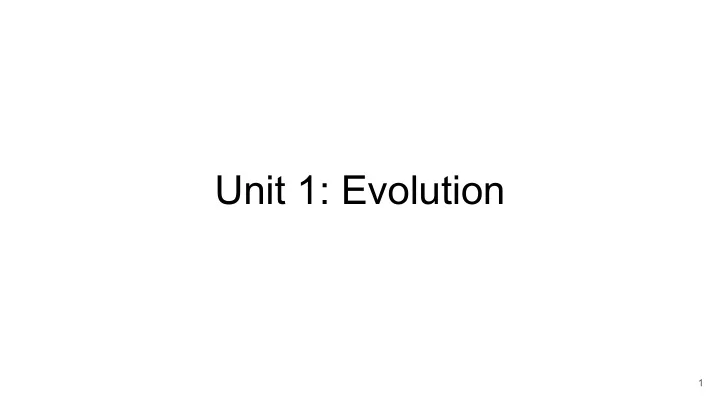

Unit 1: Evolution 1
Summary - Mon and Wed 1. Wrap up red tape 2. Short answers - the tautology 3. Recap scientific method/inference to the best explanation 4. The natural sciences before Darwin 5. Influences on Darwin's theory of evolution by natural selection 6. Darwin's theory 7. Opposition to Darwin 2
Short answer questions and science writing Instructions (will also be on the test and creason.co) Answer each question in less than three sentences. Do's Simplicity Jump right in Do not's Plagiarize or quote (use own words) Go over three sentences (unless specified) 3
Natural Selection - Initial requirements I ndividuals with favorable variations --> survive and reproduce at higher rates 1. Populations grow faster than the growth of available resources. 2. Populations have differential variation among members 3. More offspring are produced than survive due to competition for resources. 4. Individuals with favorable traits (speed, disease resistance, size) are more likely to survive* than individuals without those traits. Fitness - A relative measure of reproductive success. *Not who can live the longest but who can survive long enough to reproduce. 4
Natural Selection 5. Favorable traits determined by environmental context 6. Offspring resemble their parents Reproductive success - favorable traits are inherited and become more common. 7. This favorable variations accumulates in a population over many generations so newer generations are distinct from ancestral generations. New species emerge 8. Geographical isolation - populations become geographically isolated and over time they respond to selective pressures - different ecological contexts - to become distinct species. 5
Natural Selection in Action Reproductive success - favorable traits are passed on with a higher frequency compared to less advantageous traits which decrease in frequency over time. Selective pressures - Environmental forces influencing the reproductive success of individuals in a population. Fitness - A relative measure of reproductive success. Adaptations - The evolutionary shifts in the variation of traits in a population in response to environmental changes. 6
Natural Selection in Action Peppered Moths Industrial melanism in populations of peppered moths documented. Shifts of pigment pattern frequencies in response to the change in the environment caused by the industrial revolution. Such responses are called adaptations . 7
Natural Selection in Action - Finches WHAT: Galapagos island finch population -Beak thickness changed over time in the population of medium ground finches. -a favorable trait (thicker beaks) confers a selective advantage in a population over time. Thicker-beaks had greater reproductive success during droughts . (Resources were limited) 8
Natural Selection in Action - Finches Finches competed for limited resources -Thomas Malthus inspired Members of finch population varied in beak size Ex. 13 species among the Galapagos Islands 9
Natural Selection - Insights Gained from examples 1. Traits are inherited - otherwise natural selection cannot act -styling your hair with lots of product are not hereditary. 2. Populations of individuals exhibit biological variation of characteristics -Selection also only works on existing variation! 3. Fitness is relative - it changes relative to environmental change -Finch beak size correlated with extended periods of drought on the islands 4. Natural selection only acts on traits that affect reproduction -Traits expressed after an organism reproduces are not influenced by natural selection -Not who can live the longest but who can survive and reproduce. 10
Natural Selection - Main Points *Darwin was able to recognize that it was variation among the individuals of a population that contributed to the change in a species over time. Think about clones. Natural selection operates on individuals but it is the population that evolves Unit of Natural Selection - Individual Unit of Evolution - Population Individuals don't change genetically but overtime populations do. 11
Common Ancestry - Finches Evolution demonstrated in the finch populations found on the Galapagos islands 12
Common Ancestry - Finches 13
Issues with Darwin's Evolutionary Theory ??? 14
Precursors Recap James Hutton (1726-1797) -First to use Uniformitarianism -the processes we see today to explain the geological history John Ray (1627-1705) of our planet -Identified reproductive isolation of species -First to use "species" and "Genus" Georges Cuvier (1769-1832) -Extinction Carolus Linnaeus (1707-1778) -Catastrophism -Binomial Nomenclature -Taxonomic classification of biological Charles Lyell (1797-1875) organisms -Father of modern geology -The processes happening today were the same in the past: Comte de Buffon (1707-1788) Uniformitarianism -Plants and animals interacted with the environment Alfred Wallace (1823-1913) -Changes in the environment correlated with -Independently generated the concept of Natural Selection changes in plants and animals -Father of Biogeography Jean-Baptiste Lamarck (1744-1829) Thomas Malthus (1766-1834) -Species change influenced by environmental -Populations grow exponentially while food change supplies/production grow arithmetically -First to really attempt and explain evolutionary -Populations outgrow food supply - survival of individuals process 15 dependent on access to food supply or resources
Recommend
More recommend